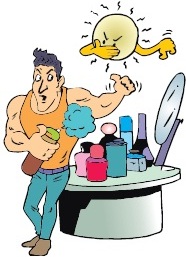Nov.18: ENVIRONMENT MATTERS
- Posted by CERC India
- Posted in November
Shampoos and deos major source of air pollution
They contain a chemical that reacts with sunlight to form particulate matter (PM) and ozone
When we shampoo our hair in the morning or spray deodorant on before going out, do we ever wonder whether we are adding to air pollution? Probably not.  That’s because we think the primary causes of air pollution are automobile and industrial emissions. A recent study has found that the use of personal care products is a major source of air pollution in urban areas.
Scientists at the University of Colorado in Boulder say that beauty and personal care products contribute nearly as much to air pollution as vehicles do. They say during the day, chemicals in deodorants, lotions, shampoos, hair gels and perfumes evaporate from the skin and enter the air.
The Boulder research, published in the journal Environmental Science and Technology, recorded levels of over 100 types of volatile organic compounds (VOCs) in the city. When VOCs come into contact with sunlight they react to produce harmful forms of pollution like particulate matter (PM) and ozone.
PM aggravates the severity of chronic lung diseases, can lead to heart attacks and increases susceptibility to viral and bacterial pathogens. Ozone is linked to asthma, lung disease, heart attacks and premature death. It also has adverse effects on vegetation and ecosystems.
It has been known that household cleaning products and personal care items emit VOCs. But, so far it was thought that vehicle emissions were the biggest source of the pollutant, especially in urban areas.
Chemical identified
 The Boulder researchers found elevated levels of D5 siloxane, which is commonly added to deodorants, lotions and shampoos to make skin softer and hair silkier. In fact, the concentrations of D5 siloxane were just as high as benzene, one of the most common contaminants from car exhausts. It should be noted that D5 is only one chemical emitted by personal care products.
According to the researchers, emissions from personal care products make their way into the atmosphere when we have the windows open or spend time outdoors but also through the ventilation systems of our cars, homes and workplaces.
People use products that contain 100-200 milligrams of D5 every day – roughly the weight of half an aspirin tablet. A fraction ends up in the drain when we shower, but most of what remains on our bodies ends up in the atmosphere.
The research team found that D5 concentrations were highest in the morning – the time when most people shower, apply personal care products and leave the house for work. They estimated that the population of Boulder emits 3 to 5 kg of D5 per day and that their cars emit about 15 kg of benzene in vehicle exhaust.
True, it takes more fuel to power your vehicle engine than it does deodorant to keep you smelling fresh. But, for every kg of fuel that’s burned, only one gram is released into the air. In the case of personal care products, the pollutants evaporate completely.
Microplastic pollution
This is not the first time cosmetics have been in the spotlight due to their negative effects on the environment. Plastic microbeads used in exfoliating face scrubs and toothpaste were banned in the USA in 2015 and in the UK the following year. Before the ban, thousands of tons of microbeads washed into the sea every year. They not only harm wildlife, but also humans who ate marine products.
Another tiny but significantly damaging beauty product is glitter. It’s shiny, it’s fun, and it seems harmless. Actually, glitter is made using etched aluminum bonded to polyethylene terephthalate (PET). Just like the microbeads, glitter is a form of microplastic.
In sum, being more aware of what we consume is a crucial aspect of protecting the Earth. By curbing our use of personal care products we can ensure that our planet is a little less polluted.
Sources: Daily Mail, www.pollutionsolutions-online.com, www.health.com, edgylabs.com





